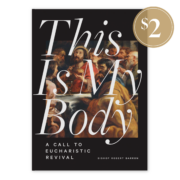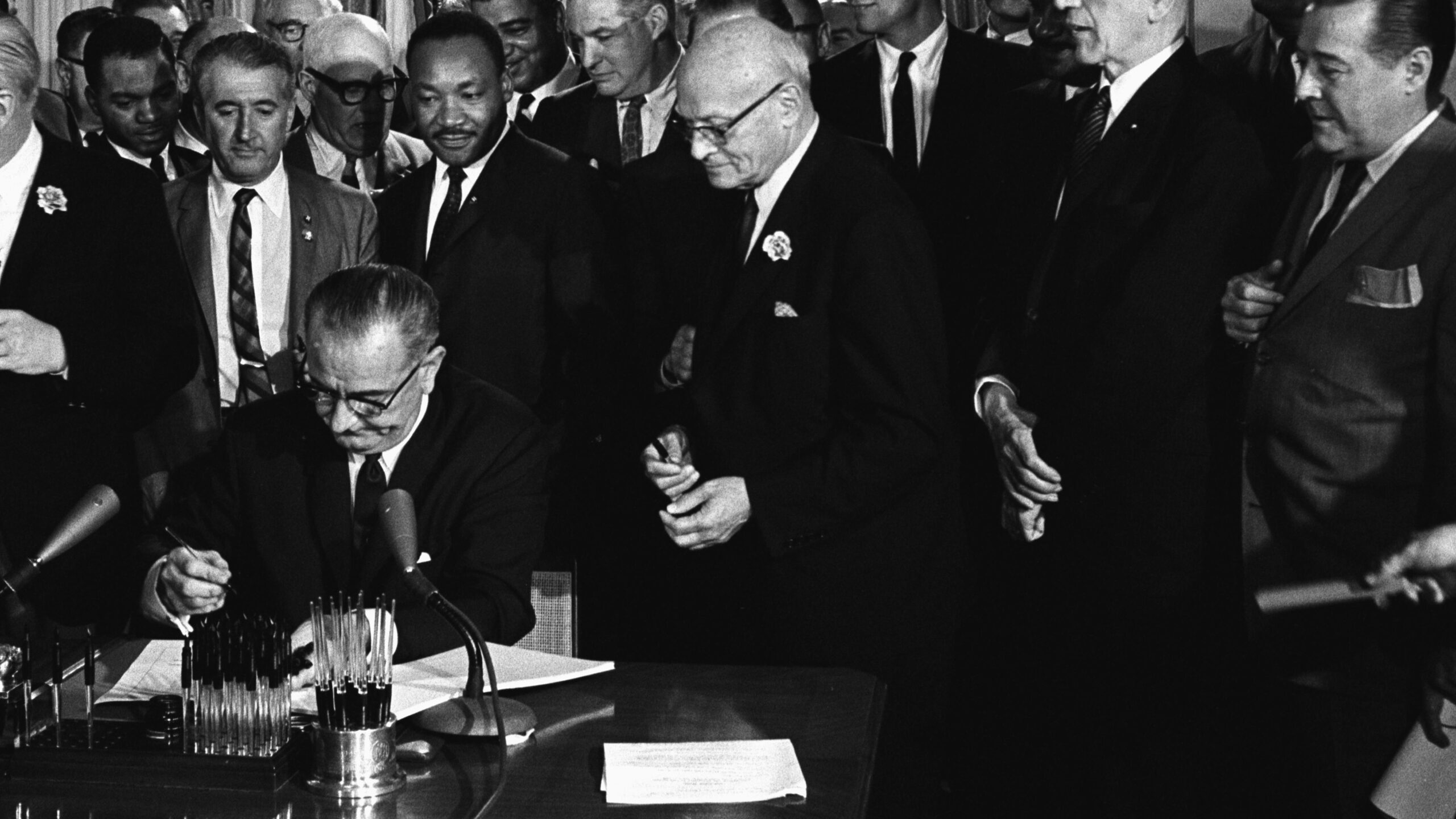Years ago, my family visited the Lyndon B. Johnson Presidential Library in Austin, Texas. Nestled on the campus of the University of Texas, the massive, spare, ten-story block of stately travertine is undoubtedly imposing. And simply knowing that this library holds forty-five-million documents of the former president and one time “Master of the Senate” is daunting for anyone planning on spending a few leisurely vacation hours sniffing around.
When we first walked in, we encountered LBJ’s charcoal-colored Lincoln Continental stretch limousine to our left and a wall adorned with countless presidential pens that signed consequential bills into law (Medicare and Medicaid among them) on our right. But at the end of the hallway in front of us was a massive wall displaying the photograph of President Johnson signing the Civil Rights Act of 1964. Over his shoulder, with unlined brow and the softest of smiles, was the man without whom this legislation would not have happened: the Reverend Dr. Martin Luther King Jr.
When I considered the gravity of the moment captured in this image, I was simply stunned. Following the passage of the 13th, 14th, and 15th Amendments (constitutional amendments passed between 1865 and 1870, which abolished slavery, granted citizenship, and secured voting rights, respectively), the blight of segregation crept in. Local legislation (Jim Crow laws) aided by pernicious Supreme Court decisions (Plessy v. Ferguson and others) craftily undermined the near-inviolability of the constitutional amendments. Thus, a codified system of racism continued to plague our land (notwithstanding encouraging fits and starts, including Truman’s executive order desegregating the military, the Supreme Court’s Brown v. Board of Education ruling, and Eisenhower’s signed Civil Rights Act of 1957) for nearly one hundred years. That is, until this photograph’s moment.

The Civil Rights Act of 1964, a bill that survived a sixty-day filibuster led by southern democrats, offered improved voting rights; desegregation of private businesses, public facilities, public education; and efforts to mitigate workplace discrimination (among other indispensable rights). To be sure, it was achieved with legislative threats and enticements, horse-trading, and arm-twisting. But it also came in the wake of freedom riders and bus boycotts, church-bombings and burning crosses, lunch counter sit-ins and letters from jail, police dogs and water cannons. The bill was signed into law on July 2, 1964.
But as I stood transfixed before that huge photograph at the hall’s end and saw that boyish, thirty-five-year-old face, I wondered: What is it that informed the spirit of the long-suffering, hope-haunted Martin Luther King Jr? When addressing the august audience in Oslo upon receiving the 1964 Nobel Peace Prize, he told us.
King paused at the beginning of his speech to ask, in his rich-timbred and steady baritone voice, a rhetorical question. Why should a man (and a movement) engaged in relentless struggle that has not yet achieved the peace so greatly desired deserve a Nobel Peace Prize? He offered his own answer:
After contemplation, I conclude that this award which I receive on behalf of that movement is a profound recognition that nonviolence is the answer to the crucial political and moral question of our time—the need for man to overcome oppression and violence without resorting to violence and oppression. Civilization and violence are antithetical concepts. Negroes of the United States, following the people of India, have demonstrated that nonviolence is not sterile passivity, but a powerful moral force which makes for social transformation. Sooner or later all the people of the world will have to discover a way to live together in peace, and thereby transform this pending cosmic elegy into a creative psalm of brotherhood. If this is to be achieved, man must evolve for all human conflict a method which rejects revenge, aggression and retaliation. The foundation of such a method is love.
Further on, he would add:
I accept this award today with an abiding faith in America and an audacious faith in the future of mankind. I refuse to accept despair as the final response to the ambiguities of history. I refuse to accept the idea that the “isness” of man’s present nature makes him morally incapable of reaching up for the eternal “oughtness” that forever confronts him. I refuse to accept the idea that man is mere flotsam and jetsam in the river of life, unable to influence the unfolding events which surround him. I refuse to accept the view that mankind is so tragically bound to the starless midnight of racism and war that the bright daybreak of peace and brotherhood can never become a reality. . . . I believe that unarmed truth and unconditional love will have the final word in reality. This is why right temporarily defeated is stronger than evil triumphant.
What Martin Luther King Jr. did (along with the civil rights movement) is refuse to answer hate with hate, vengeance with vengeance, racism with racism. The cycle, he insisted, had to end. And if that isn’t rooted in the essence of the teachings of Christ, then nothing is. Love your enemy. Turn the other cheek. He who lives by the sword, dies by the sword. And, of course, Have faith in God. Amen, I say to you, whoever says to this mountain, “Be lifted up and thrown into the sea,” and does not doubt in his heart but believes that what he says will happen, it shall be done for him.

The good Reverend King knew full well that Christ himself bore the crushing weight of the sins of mankind and didn’t lash out with vengeful, fiery, and righteous obliteration. Instead, he absorbed the darkness in its entirety and, in turn, emitted sweet, enduring, salvific light. Martin Luther King Jr. spoke to the necessity of breaking the cycle when he confessed, “I say to myself that hate is too great a burden to bear. I have decided to love.” And this awoke the conscience of the world.
To be sure, we live in an age of rage and resentment where scores, it is insisted, must be settled. But that young face in the picture on the Johnson Library wall with many battles behind him and only four tumultuous years left to live—that man, Martin Luther King Jr.—begged to differ. The burden is too great, far too great to bear, he told us.
“I have decided to love.”
